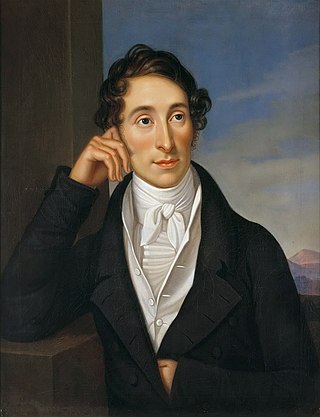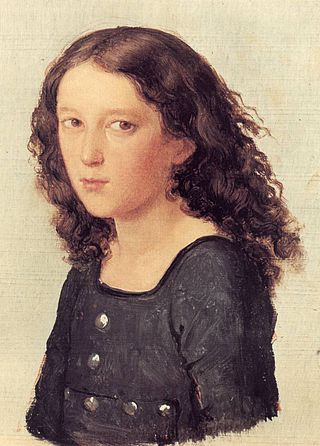Media

Grand Duo Concertant for clarinet and piano
Problems playing these files? See media help.
The Grand Duo Concertant, Opus 48, J204, is a three-movement work for clarinet and piano composed by Carl Maria von Weber from 1815 to 1816. It is a virtuosic piece for both instruments. [1] Weber most likely composed the work for himself (on piano) and his friend Heinrich Baermann, a leading clarinettist of the era, although it has also been suggested that the intended clarinettist was Johann Simon Hermstedt. [2] [3]
The three movements are as follows:
The second and third movements were completed before the first and were probably performed in 1815 for King Maximilian I Joseph of Bavaria at the Nymphenburg Palace. [4] During its composition, Weber designated the work as a sonata, but abandoned that title upon its completion. This decision reflected the work's character as more of a showcase for two virtuosos than a conventionally structured and integrated work. [5] The first movement is in sonata form, [6] the second movement is an Andante in C minor, and the finale is a lilting rondo in E-flat major. The British music critic John Warrack suggests the work could be referred to as a "double concerto without orchestra", reflecting the highly virtuosic roles for both performers. [7]
The autograph manuscript of the work is preserved in the Library of Congress.

Carl Maria Friedrich Ernst von Weber was a German composer, conductor, virtuoso pianist, guitarist, and critic in the early Romantic period. Best known for his operas, he was a crucial figure in the development of German Romantische Oper.

Mendelssohn's Piano Concerto No. 1 in G minor, Op. 25, was written in 1830–31, around the same time as his fourth symphony, and premiered in Munich on 17 October 1831. This concerto was composed in Rome during a travel in Italy after the composer met the pianist Delphine von Schauroth in Munich. The concerto was dedicated to her. Mendelssohn attended one party after another in Munich in October 1831, the month of the premiere, but he also played chamber music and taught double counterpoint. He performed the piece himself at the premiere, which also included performances of his Symphony No. 1 and the Overture from Midsummer Night's Dream. He had already written a piano concerto in A minor with string accompaniment (1822) and two concertos with two pianos (1823–24).
Songs Without Words is a series of short lyrical piano works by the Romantic composer Felix Mendelssohn written between 1829 and 1845. His sister, Fanny Mendelssohn, and other composers also wrote pieces in the same genre.
Walter, Knight Boeykens was a Belgian conductor and a world-renowned clarinetist. Boeykens' impressive discography, including several critically acclaimed performances, are testimony to his status as one of the most notable clarinetists of the 20th century. Boeykens remained active and was in concert frequently all around the world until his death in 2013.
Carl Maria von Weber wrote his Clarinet Concerto No. 2 in E♭ major, Op. 74, J. 118 in 1811, and premiered on December 25, 1813. It is composed of three movements:
Carl Maria von Weber's Concerto for Bassoon in F Major, Op. 75 was composed in 1811 for Munich court musician Georg Friedrich Brandt, was premiered on December 28, 1811, and then revised in 1822. Primarily an opera conductor and composer, Weber had only arrived a few months earlier in Munich, where he was extremely well received. The concerto is one of two pieces written for bassoon by Weber, the other being Andante e Rondo Ungarese, Op. 35. A typical performance lasts 18–20 minutes.

The Clarinet Sonata in E-flat major is a composition for clarinet and piano by Felix Mendelssohn.

The Piano Sonata No. 1 in C major, Op. 1, of Johannes Brahms was written in Hamburg in 1853, and published later that year. Despite being his first published work, he had actually composed his Piano Sonata No. 2 first, but chose this work to be his first published opus because he felt that it was of higher quality. The piece was sent along with his second sonata to Breitkopf & Härtel with a letter of recommendation from Robert Schumann. Schumann had already praised Brahms enthusiastically, and the sonata shows signs of an effort to impress in its symphonic grandeur, technical demands, and dramatic character. It was dedicated to Joseph Joachim.
Sonatas, duos and fantasies by Franz Schubert include all works for solo piano by Franz Schubert, except separate dances. They also include a number of works for two players: piano four hands, or piano and a string instrument.

The Sonata in C minor is a keyboard sonata composed by Joseph Haydn in 1771. It is also referred to as a piano sonata. The three-movement work was published by Artaria in 1780 in a set of six sonatas dedicated to the sisters Katharina and Marianna Auenbrugger.
Carl Maria von Weber wrote his Concertino for Clarinet in E-flat major, Op. 26, J. 109, for clarinettist Heinrich Bärmann in 1811. Weber wrote the work in three days between March 29 and April 3. Bärmann learned the work over the next three days and the command performance, for which King Maximilian I of Bavaria purchased 50 tickets, took place on the evening of April 5.

The Concerto for Piano, Violin, and Strings in D minor, MWV O4, also known as the Double Concerto in D minor, was written in 1823 by Felix Mendelssohn when he was 14 years old. This piece is Mendelssohn's fourth work for a solo instrument with orchestral accompaniment, preceded by a Largo and Allegro in D minor for Piano and Strings MWV O1, the Piano Concerto in A Minor MWV O2, and the Violin Concerto in D minor MWV O3. Mendelssohn composed the work to be performed for a private concert on May 25, 1823 at the Mendelssohn home in Berlin with his violin teacher and friend, Eduard Rietz. Following this private performance, Mendelssohn revised the scoring, adding winds and timpani and is possibly the first work in which Mendelssohn used winds and timpani in a large work. A public performance was given on July 3, 1823 at the Berlin Schauspielhaus. Like the A minor piano concerto (1822), it remained unpublished during Mendelssohn's lifetime and it wasn't until 1999 when a critical edition of the piece was available.
From March 1816 to August 1817, Franz Schubert composed four violin sonatas. All four were published after the composer's death: the first three, D 384, 385 and 408, as Sonatinas in 1836, and the last one, D 574, as Duo in 1851. Schubert composed two more pieces for violin and piano, in October 1826 and December 1827 respectively: a Rondo, D 895, which was published during the composer's lifetime (Op. 70), and a Fantasy, D 934, which was premiered in January 1828, less than a year before the composer's death.

Shirley Brill is an Israeli clarinetist living in Germany.
Carl Maria von Weber's Piano Sonata No. 2 in A-flat major, Op. 39, is a piano sonata in four movements. Weber started his piano sonata in 1814 and completed it in 1816.
Etcetera Records, Roeland Hendrikx Ensemble, C.M. von Weber (Grand Quintetto op.34, Grand Duo Concertant op.48, Variations on a theme of Silvana op.33) (2017)